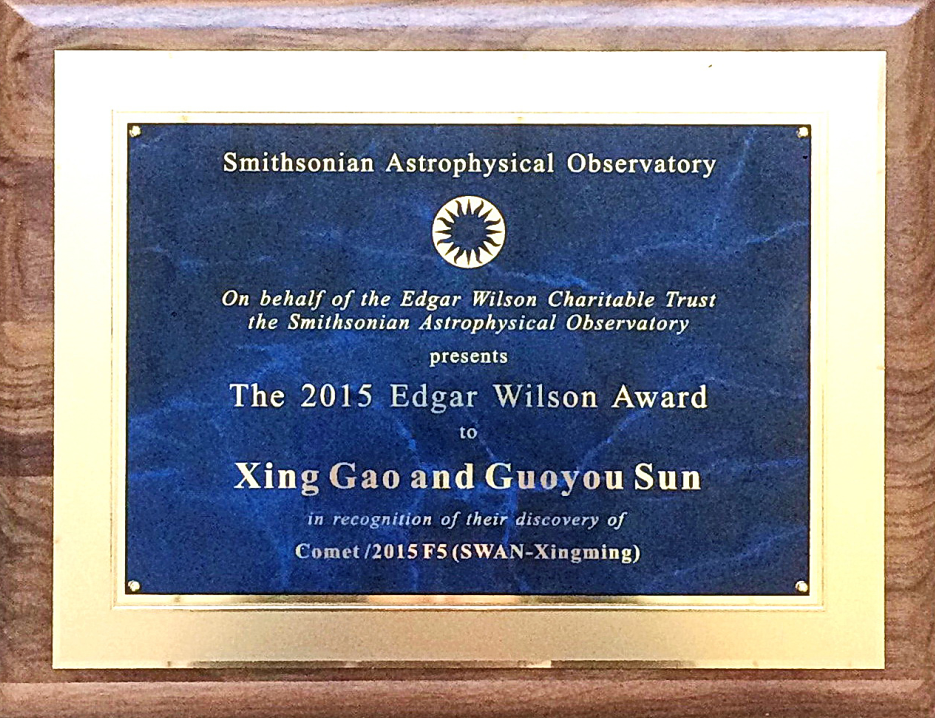Introduction
My name is Guoyou Sun. I go by G. Sun or G. -Y. Sun for short. Sun is my surname and Guoyou is my given name. Chinese names are written in surname-first order. Hence, my name should really be written as Sun Guoyou (孙国佑 in simplified Chinese, 孫國佑 in traditional Chinese).
I was born in 1984 in Yueqing City, Zhejiang Province, People’s Republic of China. As an amateur astronomer, I’m passionate about discovering new celestial objects and am a proud member of both the Chinese Astronomical Society and the Xingming Observatory Sky Survey team . Notably, I am one of the co-discoverers of the famous luminous red nova V1309 Sco, often referred to as the “Rosetta Stone” for understanding stellar mergers. I also led the team to discover the first light of the nearby supernova SN 2023ixf. The related achievements were published in the journal Nature. In recognition of my work, I was awarded the 2015 Edgar Wilson Award for the discovery of Comet C/2015 F5 SWAN-Xingming. It is an honor to have an asteroid named after me, designated (546756) Sunguoyou. and I have accomplished a grand slam in the discovery of celestial body types and hold the record for the most discoveries of new celestial body types in the world.

I have discovered hundreds of new celestial bodies. Including comets, asteroids, near-earth asteroids, exoplanets, supernovae, novae, luminous red novae, nova-like stars, dwarf novae, young stellar objects, active galactic nucleus, brown dwarfs, eclipsing binaries, pulsating variables, eruptive variables, rotational variables, X-ray variables, strong gravitational lens, microlensing events, multiple star systems, planetary nebulae, HII region, open star clusters, double stars, and so on.
- Public Supernova Project (PSP) in China: Administrator
- Yueqing Association for Youth Science and Technology Education: Chairperson
- China Skywatcher Asteroid Search Campaign: Director
- The International Astronomical Search Collaboration (IASC): Trainers
- Wenzhou Youth Astronomy Club: Advisor
- 1. The Discovery of an Equal-mass Twin Binary System by Online Sky Survey Images,Journal of Double Star Observations, Vol. 16 No. 4 August 1, 2020 p401-402,http://www.jdso.org/volume16/number4/Sun_401_402.pdf
- 2. Discovery of new member of WDS 02137-0302,WDS 02137-0302 B may not be physical,Journal of Double Star Observations, Vol. 16 No. 4 August 1, 2020 p403-404,http://www.jdso.org/volume16/number4/Sun_403_404.pdf
- 3. Searching for eclipsing binaries in the area of RA: 02h 21m 36s , DEC: +57°11′32″,Monthly Notices of the Royal Astronomical Society, Volume 497, Issue 3, September 2020, Pages 3381–3392, https://doi.org/10.1093/mnras/staa2170
- 4. The Unusual Eruption of the Extragalactic Classical Nova M31N 2017-09a,The Observatory 140 (2020) 85-93,https://ui.adsabs.harvard.edu/abs/2020arXiv200610118L
- 5. Extremely low mass ratio contact binaries — I. the first photometric and spectroscopic investigations of ten systems, The Astronomical Journal, Volume 164, Number 5, October 2022, http://dx.doi.org/10.3847/1538-3881/ac8ff2
- 6. The First Photometric and Orbital Period Investigation of an Extremely Low Mass Ratio Contact Binary with a Sudden Period Change, TYC 4002-2628-1, Monthly Notices of the Royal Astronomical Society, Volume 517, Issue 2, December 2022, Pages 1928–1936,https://doi.org/10.1093/mnras/stac2811
- 7. Photometric and spectroscopic studies of the long period low mass ratio deep contact binary KN Per, Publications of the Astronomical Society of the Pacific, Volume 134, Number 104, https://iopscience.iop.org/article/10.1088/1538-3873/ac99fd
- 8. The first photometric and spectroscopic analysis of the neglected totally eclipsing contact binary NSVS 2536063, New Astronomy, Volume 98, January 2023, https://www.sciencedirect.com/science/article/pii/S1384107622001038?dgcid=coauthor
- 9. TOI-4562 b: A highly eccentric temperate Jupiter analog orbiting a young field star, The Astronomical Journal, Volume 165, Number 3, February 2023, http://dx.doi.org/10.3847/1538-3881/acb5a2
- 10. The study of eleven contact binaries with mass ratios less than 0.1, Monthly Notices of the Royal Astronomical Society, Volume 519, Issue 4, March 2023, Pages 5760–5774, https://doi.org/10.1093/mnras/stad026
- 11. The First Photometric and Spectroscopic Studies of ASASSN-V J015428.67+204247.2 and its Relation to the Population of Low Mass Ratio Contact Binaries, Publications of the Astronomical Society of the Pacific, Volume 135, Number 1047, https://iopscience.iop.org/article/10.1088/1538-3873/acc7cb
- 12. Flares confirmed for the first time to be from the primary component of an eclipsing binary, Monthly Notices of the Royal Astronomical Society, Volume 527, Issue 2, January 2024, Pages 3982–3994, https://doi.org/10.1093/mnras/stad3251
- 13. A shock flash breaking out of a dusty red supergiant, nature 627, pages754–758 (2024), https://www.nature.com/articles/s41586-023-06843-6
- 14. The first analysis of three long-period low mass-ratio Contact Binaries, Monthly Notices of the Royal Astronomical Society,Volume 527, Issue 3, January 2024, https://doi.org/10.1093/mnras/stad3591
- 15. The Initial Mass Function Based on the Full-sky 20-pc Census of ∼3,600 Stars and Brown Dwarfs, The Astrophysical Journal Supplement Series, Volume 271, Number 2,https://iopscience.iop.org/article/10.3847/1538-4365/ad24e2
- 16. 89 New Ultracool Dwarf Co-Moving Companions Identified With The Backyard Worlds: Planet 9 Citizen Science Project,http://export.arxiv.org/abs/2403.04592
-
- Planetary nebulae discovered and confirmed by amateur astronomers, Proceedings of the Annual meeting of the French Society of Astronomy and Astrophysics, December 2018, http://sf2a.eu/proceedings/2018/2018sf2a.conf..0443l.pdf
- The optical re-brightening of M31N 2017-09a,ATel #11070,http://www.astronomerstelegram.org/?read=11070
- Detection and follow-up observation of SN 2020aeps, the first discovery of XMO-PAT Survey,ATel #14313,http://www.astronomerstelegram.org/?read=14313
- Recurrent Nova M31N 2008-12a: Pre-detection upper limit and multicolor follow-up observations of 2021 eruption with XMO-NEXT,ATel #15037,http://www.astronomerstelegram.org/?read=15037
- M31N 2019-09d and M31N 2022-03d are Confirmed as the Second and Third Observed Eruptions of the Recurrent Nova M31N 2017-01e,ATel #15729,http://www.astronomerstelegram.org/?read=15729
- Recurrent Nova M31N 2008-12a: Multicolor follow-up observations of 2022 eruption with XMO-NEXT,ATel #15795,http://www.astronomerstelegram.org/?read=15795
- Onset of SN 2023ixf observed over East Asian longitudes, AstroNote 2023-130, https://www.wis-tns.org/astronotes/astronote/2023-130
- M31N 2013-10c (= AT 2023yoa) is a Recurrent Nova in M31, ATel #16354,https://www.astronomerstelegram.org/?read=1635
- Recurrent Nova M31N 2008-12a: discovery of the 2023 eruption with Half Meter Telescope at Xingming Observatory,ATel #16361,https://www.astronomerstelegram.org/?read=16361
- Recurrent Nova M31N 2008-12a: pre-discovery observations with LATTE at Lulin Observatory,ATel #16365,https://www.astronomerstelegram.org/?read=16365
Awards and Honors
◇ The 2015 Edgar Wilson Award
◇ Other awards
 |
 |
 |
 |






